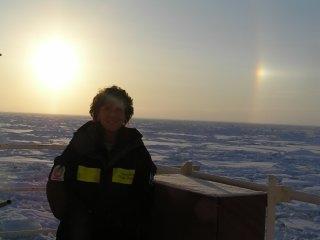3 September, 2004
Sunshine on the Ice and Drilling Frustrations
The good news weather-wise here is that we are finally getting some sunlight
during the daytime hours. Most often this sun appears late at night and into
the wee hours of the morning. It is so nice to see the blue sky instead of
the clouds and fog. The sunlight adds new dimensions and definition to the
icy "waterscape" around us and continually presents new opportunities for
photographs. At the same time the icebreaker Oden is constantly on the move,
changing direction while breaking ice away from the Vidar Viking. Standing
in one place on the deck, the scene in front of you is constantly shifting
so new photo opportunities present themselves over and over again.
As for the drilling operation, on September 1st we reached the continental
rock beneath the sediments we have been sampling. The goal was to drill down
to this "basement"; it appears that the depth of this margin is about 410
meters below the seafloor.
The next day, after reaching the basement there was an attempt to "log" the
drill hole. In this operation two instruments are lowered one at a time on
an electrical-mechanical cable to the bottom depth. As each logging tool is
slowly raised to the surface, it gathers data such as soil porosity, natural
radioactivity, density, and sound velocity and transmits that data to the
surface. Unfortunately this turned out to be a frustrating task as each time
the logging tool was lowered it got hung up in the drill bit and could not
pass through. After several attempts to fix the problem it was decide to
stop the logging process.
The problem turned out to be a piece of rock, presumably from the basement
bedrock, that was jammed into the drill bit. Very early this morning the
rock was removed and the operation went forward. Now the drilling continues
in a new hole not far from this last one. The object now is to gather
sediment cores from the sections that were not fully recovered before. In
this way a more continuous sediment sequence can be obtained. At the same
time they are collecting missing segments of the sediments, they will use a
temperature probe to track the change in sediment temperature with depth.
The sediments gathered and analyzed already have been dated to approximately
80 million years ago, to the Cretaceous period, the time before the dinosaur
extinction. Amazing, amazing!

The Sovetskiy Soyez with sun and fog.

On the Oden deck with a summer sun halo behind me
Contact the TEA in the field at
.
If you cannot connect through your browser, copy the
TEA's e-mail address in the "To:" line of
your favorite e-mail package.
|
